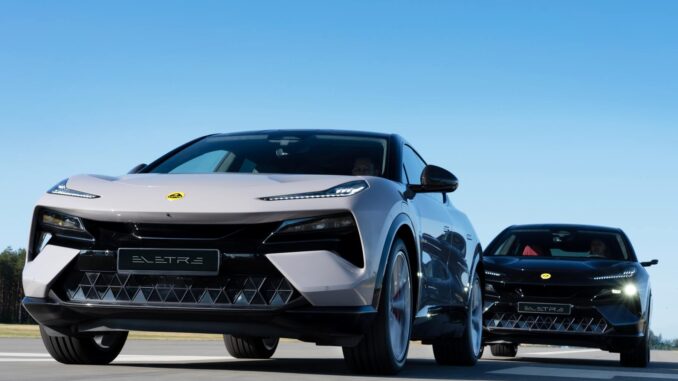
Lotus Eletre – The ongoing transformation of Lotus to a truly global performance business and brand has reached its most significant milestone yet – the arrival of the Eletre hyper-SUV.
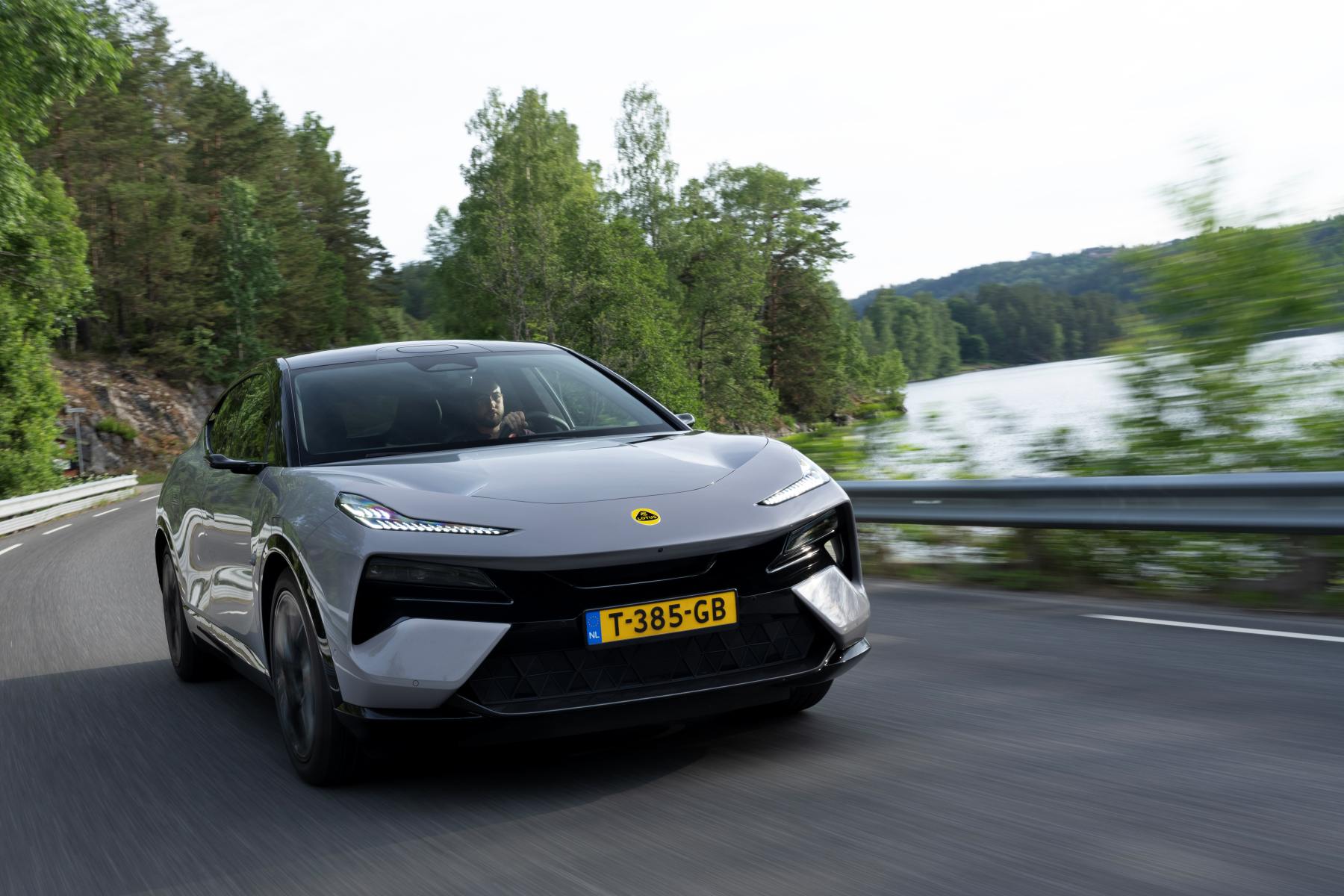
- Aimed at a new generation of Lotus customer seeking a practical, versatile and spacious family-focused electric hyper-SUV
- The most advanced Lotus ever, Eletre blends comfort, performance and cutting-edge luxury design with sustainable materials
- State-of-the-art infotainment system uses Lotus Hyper OS to deliver intuitive and immersive experience for all occupants
- A true Lotus – Eletre blends the core DNA of Emira and Evija, reinterpreting them as a hyper-SUV with advanced suspension and chassis tech
- High level of quality in fit and finish, materials and design
- World-class ride and handling built on Lotus’ pioneering development of active systems in road and race cars
- Active aerodynamics – including striking front grille – means optimised range and efficiency, plus additional downforce for superior driving experience and high-speed stability
- Powerful, efficient and refined all-electric powertrain delivers the perfect balance of performance, responsiveness and range – up to 600km (373 miles) WLTP Combined
- 0-100 km/h (0-62mph) in under three seconds makes Eletre R world’s fastest dual-motor pure electric SUV
- Rapid charging from 10-80 per cent in only 20 minutes, and up to 120 km (74 miles) of range in just five minutes
- Full suite of advanced driver assistance systems featuring innovative deployable LIDAR system
- Over-the-air updates to deliver latest functionality and software to Eletre customers
- Eletre is future-proofed for Level 4 autonomous driving capability
- Available to order now, priced from £89,500 in the UK and €95,990 in Europe
- Configure your perfect Eletre here
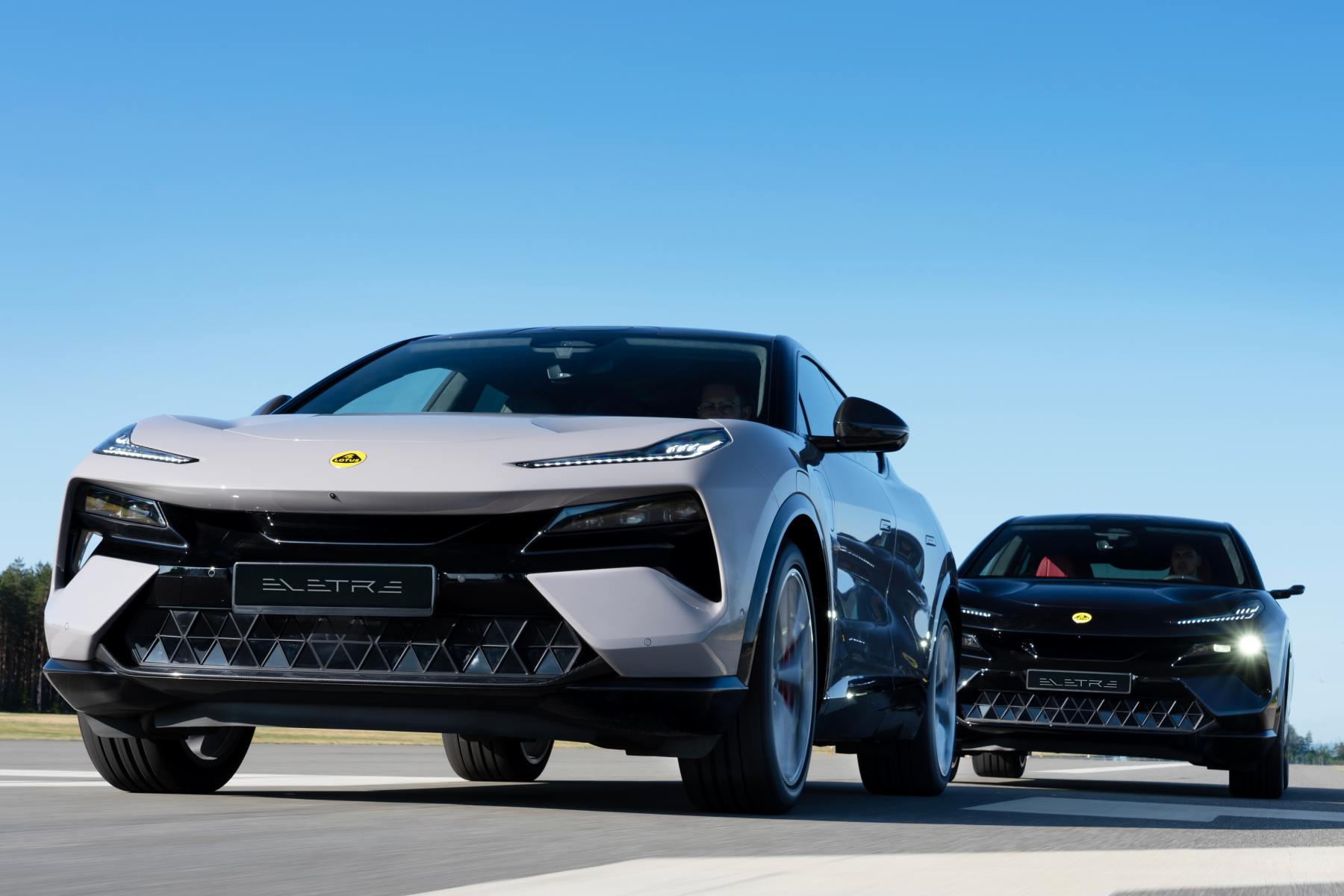
Lotus Eletre Hyper SUV
The Lotus Eletre is a striking and progressive new model, the first of a new breed of pure electric performance SUVs. It takes the core principles and Lotus DNA from 75 years of sports car design and engineering, evolving them into a desirable all-new lifestyle vehicle.
It’s aimed at a new generation of Lotus customers; those who value the world-class dynamic performance and striking design which have always been part of the Lotus experience, and who also need a practical, versatile and spacious family-focused vehicle – one that’s packed with the latest digital technology to make their driving life safer and more convenient.
The Eletre is a true Lotus. It takes the heart and soul of the latest Lotus sports car – the Emira – and the revolutionary aerodynamics of the all-electric Evija hypercar, and reinterprets them as a hyper-SUV. It delivers class-leading ride and handling, steering and aero performance – areas of automotive design and engineering where Lotus has both pioneered and dominated throughout its 75-year history, on road cars and race cars. It is also the epitome of beautiful design, efficient and elegant engineering solutions, embracing technology, the best craftsmanship, advanced materials, innovation and ingenuity, and pushing new boundaries. These are the very things which made Lotus great in the first place.
The Eletre is the latest in a long line of Lotus road cars whose name begins with the letter E, and it means ‘Coming to Life’ in some Eastern European languages. It’s an appropriate link as the Eletre marks the start of a new chapter in the history of Lotus – the first accessible EV and the first SUV.
The Eletre is ‘Born British, Raised Globally’, a collaboration between highly experienced and dedicated Lotus teams in the UK, Germany and China. They include the product definition and attributes teams at Hethel, the home of Lotus since 1966; the design teams at UK Creative Centre (UKCC) in Coventry; the engineering and dynamics teams at Germany Innovation Centre (GIC) in Raunheim; and the Lotus Tech engineering and manufacturing teams in Wuhan.
Following a world premiere in London in March 2022, thousands of customers around the world have already placed deposits to secure their Eletre. Three different versions of the car are available – Eletre, Eletre S and Eletre R – with the choice of two powertrains.
First customer deliveries started in China in March, and will follow in global markets – including Europe and the UK – later this summer.
Mike Johnstone, Group Vice-President and Chief Commercial Officer, Lotus, commented: “Like every Lotus, the Eletre is first and foremost a car ‘For The Drivers’. Its DNA is 100% Lotus, with exceptional dynamic performance. It’s also the most advanced Lotus ever, blending that performance with comfort, practicality, versatile space, cutting-edge tech and modern luxury design into a vehicle that brings the Lotus experience to a whole new group of customers for the first time.”
Mike added: “We know that two-seater sports cars are not for everyone, but the fantastic experience of driving a Lotus should be. The Eletre, plus the other fully electric lifestyle models that we’ve already announced, are providing customers and fans with a range of highly desirable Lotus cars that can fulfil all their needs at different times of their life. It’s a natural progression for the brand, and a hugely exciting one because Lotus is about delivering the very best performance no matter what segment the car sells in.”
Maximilian Szwaj, Vice-President of Lotus Technology and Managing Director, GIC, commented: “Since its inception exactly 75 years ago, Lotus has always been at the cutting edge of innovation, pioneering advances in aerodynamics, active systems and lightweight construction. Eletre embodies all of those fundamental qualities, and adds state-of-the-art technologies – including deployable LIDAR sensors – backed by future-proofed hardware and software. The world-class customer experience is driven by a stunning 5G-capable infotainment system powered by Lotus Hyper OS which offers best-in-class performance for visual effects and interactive feedback. Quite simply, this is the most advanced Lotus ever made.”
The Eletre’s comprehensive standard specification includes active air suspension, continuous damping control, torque vectoring, Lotus Intelligent Dynamic Chassis Control, 22-inch 10-spoke forged wheels in silver with a diamond-turned finish (20-inch five-spoke in European markets), Matrix LED headlights, Adaptive Cruise Control, Visual Park Assist, four-zone climate control, 12-way electric-adjust front seats, head-up display, wireless Apple Carplay and Android Auto, and a 1,380W 15-speaker KEF Premium Audio system.
The Eletre S is focused on customers seeking luxury. The enhanced specification includes additional features such as soft door close, privacy glass, active rear spoiler, configurable ambient lighting, illuminated side sills, air quality system, 2,160-watt 23-speaker KEF Reference Audio system, and 22-inch 10-spoke forged wheels in grey with a diamond-turned finish.
The flagship Eletre R is all about performance, and benefits from the Lotus Dynamic Handling Pack (comprising Intelligent Active Roll Control and Active Rear Steering), Carbon Pack, Pirelli P Zero performance tyres, and a gloss black finish for the wheels. There’s also a sixth Drive Mode: Track.
Eletre customers have the opportunity to tailor their vehicle to their requirements using the comprehensive list of option packs. These include the Executive Seat Pack, Comfort Seat Pack, Extended Carbon Fibre Pack, Interior Carbon Fibre Pack, Parking Pack and a Highway Assist Pack. Standard on the Eletre R, the Lotus Dynamic Handling Pack and Carbon Packs are also available for the Eletre and Eletre S. A Ceramic Brake Pack is offered on the Eletre R (and Eletre S in European markets).
For even greater customer choice and personalisation, many features from the packs are available as standalone options. There is also a wide range of colours, materials and finishes available on the interior. Available to order now, the Eletre is priced from £89,500 in the UK and €95,990 in Europe. Pricing in other regions will be announced in due course.
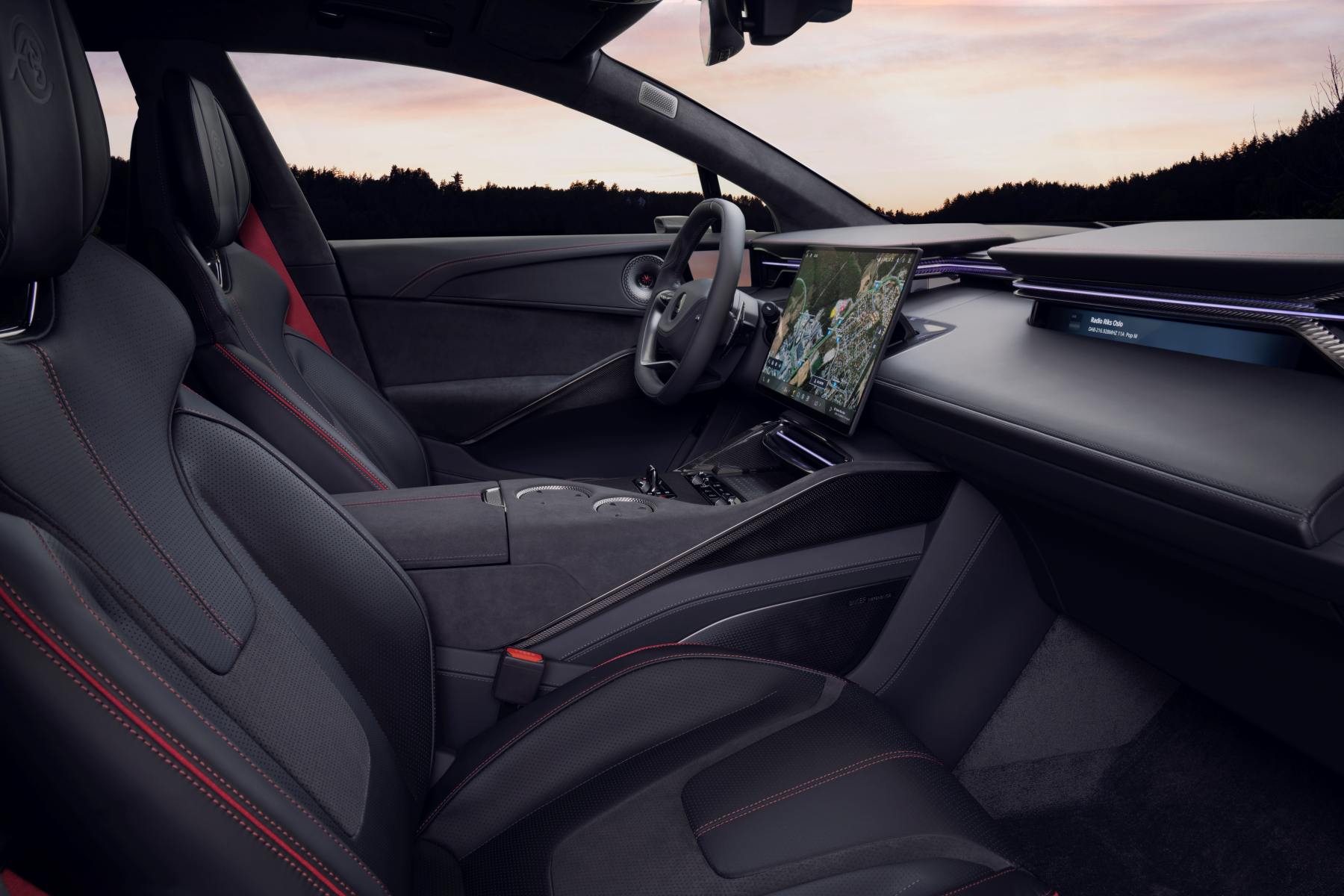
A technical tour de force
Lotus has always been one of the most innovative and technology-led automotive brands, and the Eletre is the culmination of 75 years of pioneering achievement in the fields of ride and handling, steering, aerodynamics and active systems. The result of an exhaustive global engineering development programme, the Eletre has been tested over more than one million miles in some of the harshest environments on earth, including on the challenging Nürburgring Nordschleife circuit in Germany. The Eletre fuses the fundamentals of Lotus dynamics DNA with cutting-edge chassis and driving safety technologies, state-of-the-art electric powertrains, plus a luxurious and spacious interior with world-class infotainment to deliver a new type of Lotus for enthusiastic performance car drivers worldwide.
With the Eletre, Lotus is delivering more innovation, more technology, more capability and more appeal than ever before. Offering a range of up to 600km (373 miles), the convenience of fast-charging from 10-80 per cent in just 20 minutes, and acceleration from 0-100km/h (0-62mph) in a breathtaking 2.95 seconds on the flagship R model, the Eletre takes full advantage of all the benefits electrification can offer and uses them to comprehensively enhance the driving experience.
The effortless, instant torque and all-wheel drive traction delivered by the two electric motors, together with active air suspension, also brings a completely new dimension to Lotus ownership: the ability to carry on driving where the road ends, and to tow up to 2,250kg.
A comprehensive suite of advanced driver assistance systems (ADAS) is also part of the Eletre experience: Intelligent Adaptive Cruise Control (ACC); Highway Assist (HWA); Collision Mitigation Support Front (CMSF); Traffic Sign Information (TSI); Door Open Warning (DOW); Rear Cross Traffic Alert (RCTA); Front Cross Traffic Alert (FCTA); Lane Change Assist (LCA); Life Detection and Care (LDC); Lane Keep Aid with Lane Departure Warning / Prevention (LKA+); Parking Emergency Brake (PEB); Collision Mitigation Support Rear (CMSR); and Emergency Rescue Call (E-Call). Each is designed to make every journey safer and more relaxing.
There’s also a 29-inch head-up display with semi-augmented reality that can overlay contextual graphics on to the view ahead to help the driver keep their eyes on the road. A remote parking function in the smartphone app enables the Eletre owner to manoeuvre the car into a tight parking space while outside the vehicle, making it possible to fit into spaces which would otherwise be unsuitable. The suite of state-of-the-art sensors is also future-proofed to deliver further advances in automated driving capability via over-the-air (OTA) updates.
Eletre customers in Europe benefit from a five-year / 150,000km vehicle warranty with an eight-year / 200,000km battery warranty. In the UK, customers receive a five-year / 100,000-mile vehicle warranty with an eight-year / 150,000-mile battery warranty. All customers get five years of pan-European roadside assistance.
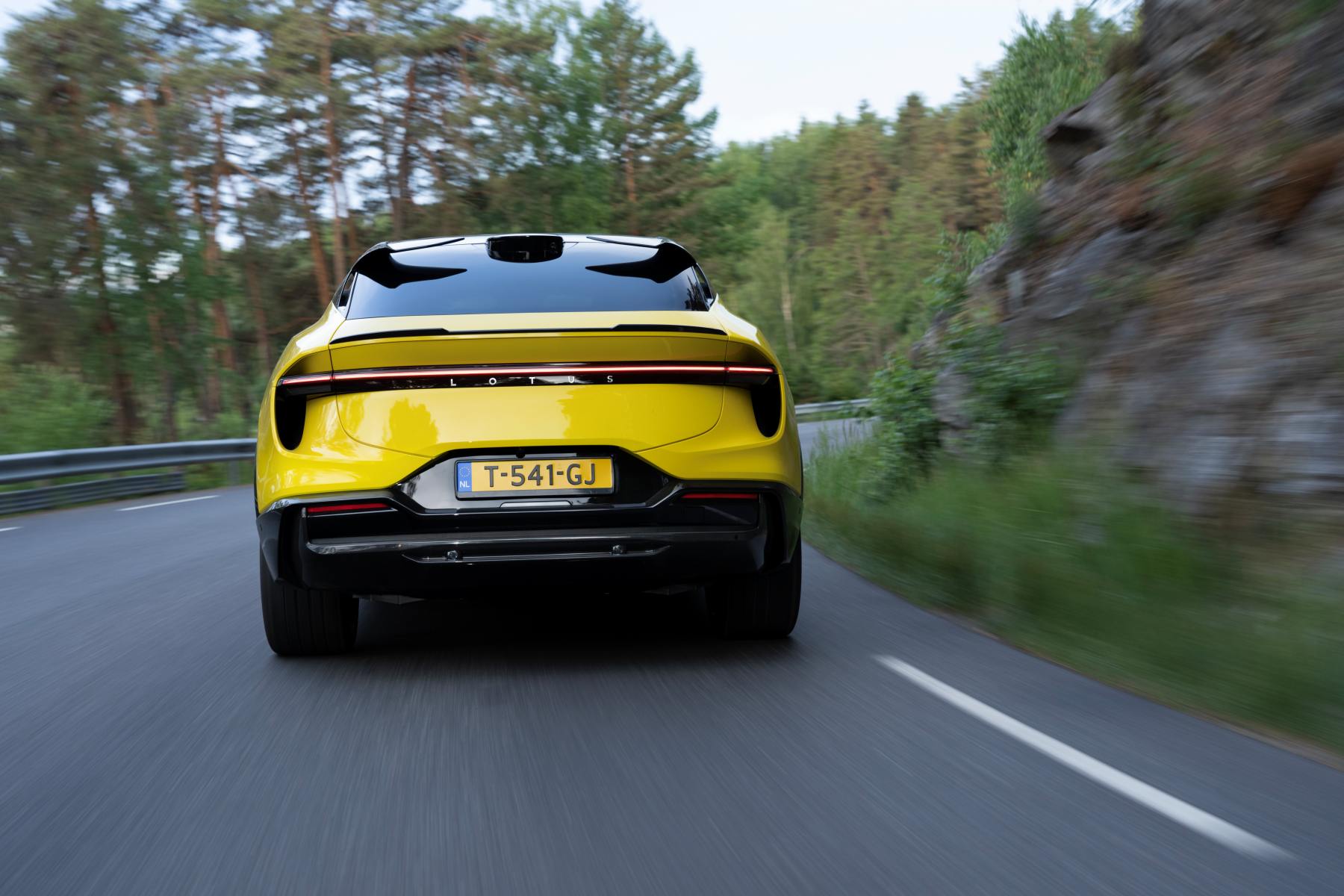
Chassis Technology and Vehicle Dynamics: A new benchmark in the SUV segment
Every Lotus has to deliver the ideal balance of agility, handling and comfort: this is fundamental to the brand’s DNA and to the unrivalled driver appeal each model offers. Through a combination of its light, stiff platform, sophisticated suspension systems and intelligent all-wheel drive, the Eletre engineering team had the ideal starting point for vehicle dynamics development. Adding even further capability are technologies such as active anti-roll control, torque vectoring by braking, and active rear-wheel steering. Networking all of these advanced technologies together so that they interact seamlessly as one, the result is an SUV that steers, corners and rides like only a Lotus can.
The Eletre features sophisticated multi-link suspension systems front and rear, with components made from lightweight aluminium. The design of each enables effective decoupling of lateral and longitudinal loads, delivering superb ride quality together with outstanding responsiveness without one attribute compromising the other.
The innovative dual-chamber air springs, fitted as standard across the Eletre range, enable independent control of ride height and stiffness. In addition to comfort and refinement, the active air suspension also provides speed-dependent lowering of the car by up to 25mm to reduce drag and therefore improve range. It can also increase ride height by between 15mm and 25mm to enhance off-highway capability.
The electronically-controlled damping system – CDC – continuously measures the loads coming into the suspension at a rate of 1,000 times per second, and adapts the damping rate 500 times per second, for improved body control without any harshness. It means the Eletre ‘breathes’ with the road, as every Lotus should.
The Eletre is the first Lotus to use electromechanical power steering. The system has been meticulously tuned to deliver the pure, truly connected feel, feedback and intuitive response to the driver’s inputs that’s a hallmark of every Lotus and for which Eletre also sets the class benchmark. And, at only 2.5 turns lock-to-lock, the steering is sports-car quick as well. With the rack-mounted motor only consuming power on-demand, the system offers greater energy efficiency than those relying on hydraulics to provide the assistance.
The active rear-wheel-steering system makes the Eletre even more agile and is another Lotus first. The technology is offered, together with Intelligent Active Roll Control (IARC), as part of the Lotus Dynamic Handling Pack that’s fitted as standard to the Eletre R and optional on Eletre and Eletre S. Actuators mounted on the rear subframe connected to the toe control arm can rotate the rear suspension knuckle by up to 3.5º. At low speeds, the rear wheels turn in the opposite direction to the fronts, effectively reducing the wheelbase and therefore reducing the turning circle by up to 0.8 metres to enhance manoeuvrability. At high speeds, the rear wheels turn in the same direction as the fronts, improving stability.
IARC is a third-generation 48-volt system featuring powerful and fast-acting electromechanical actuators. Taking their input from the body displacement sensors, their required output torque is calculated in only two milliseconds, delivering precision control of the required roll stiffness, resulting in even more neutral cornering and improved composure. When driving on smooth, flat roads, IARC effectively decouples the anti-roll bars, benefiting ride comfort.
Managing the interaction of all of these systems is Lotus’ incredible new 6D Integrated Chassis Control (ICC) system. ICC seamlessly integrates the response of each component – together with the all-wheel drive system’s torque distribution and the active aerodynamics – to perfectly balance control and comfort in every driving scenario by continuously analysing the vehicle’s behaviour across multiple dimensions: vertical, lateral and longitudinal motion, plus pitch, roll and yaw. This technology, developed in-house by Lotus, significantly expands the Eletre’s dynamic capability and delivers an even more rewarding, engaging driving experience for the customer.
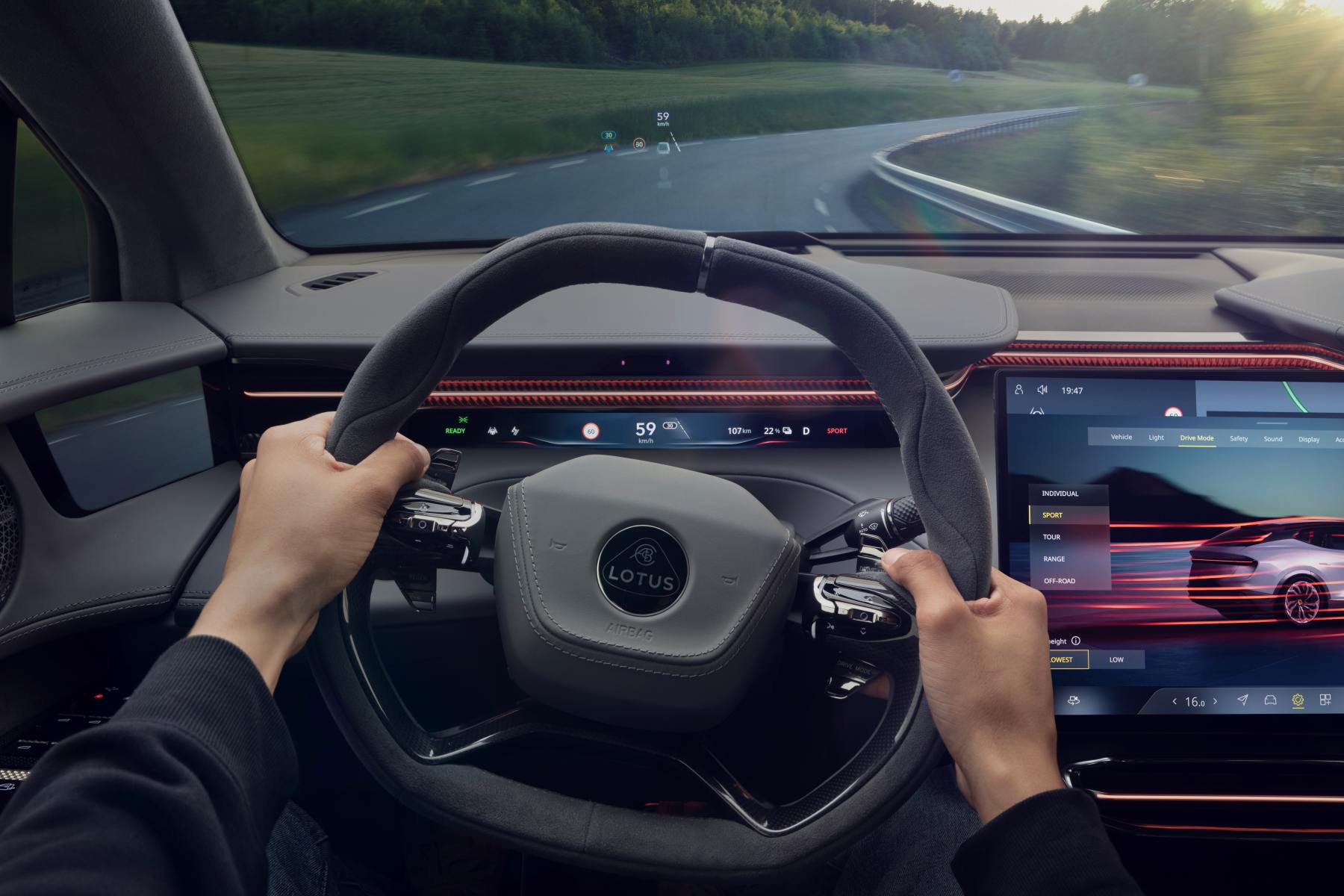
Drivers can also tailor the Eletre’s character to their individual taste by selecting one of the different Drive Modes, either through the central touchscreen or using the shift paddles behind the steering wheel. Each Mode subtly alters the vehicle’s settings to deliver a range of different benefits:
- Tour Mode is the default mode, and balances driving comfort and energy consumption
- Range Mode reduces the energy consumption of systems such as climate control, optimises front and rear torque distribution and offers a more progressive accelerator pedal response to increase range
- Sport Mode sharpens the powertrain and chassis response, enhancing drivability and handling
- Off-Road Mode can be used to enhance traction on low-friction surfaces to remove the risk of wheelspin
- Individual Mode allows the driver to choose specific settings for powertrain, suspension and steering
- Track Mode (Eletre R only) reduces ride height and powertrain response compared to Sport Mode, and also raises the threshold for the electronic stability control system’s intervention, giving the driver more influence over the vehicle’s cornering behaviour, making it ideal for spirited driving on a circuit
Comprehensive development work on the tyres and brakes has also taken place. Working in partnership with Pirelli, Lotus has engineered a range of high-performance 22 and 23-inch P Zero and ultra-high performance 22-inch P Zero Corsa tyres specifically for the Eletre. Each delivers an ideal balance of wet and dry grip, especially under the high loads resulting from the instant torque from the electric motors.
The braking system developed for the Eletre stands out for its six-piston front calipers and two-piece Brembo discs, comprising steel rotors and aluminium mounting bells. Joined together by a special casting process, these discs offer weight savings compared to conventional one-piece cast discs, and improved thermal management at high temperatures for improved braking performance – characteristics proven during the demanding testing programme at the legendary Nürburgring Nordschleife.
A carbon ceramic braking system is available as an option on the Eletre R (and Eletre S in European markets). This features AP Racing’s 10-piston ‘Radi-Cal’ calipers on the front axle: the highly optimised, asymmetric form of the forged aluminium components means they are the same weight as the six-piston calipers but offer 60 per cent more pressure area for even higher performance. They clamp Brembo’s carbon ceramic discs, which are less than half the weight of the six-piston system’s discs, and can operate at extreme temperatures exceeding 1,000ºC, offering outstanding fade resistance. They also offer a service life which is typically double that of steel discs. Calipers are available in a choice of six colours, depending on the spec chosen.
Bespoke, multi-material EV architecture: light, stiff, strong
Ensuring that the Eletre would deliver the benchmark ride, handling and agility expected of a Lotus, it was developed from day one on the all-new Electric Premium Architecture (EPA). This highly flexible, modular platform is bespoke to Lotus, and will be at the core of a range of new premium lifestyle performance EVs which will be developed over the next few years.
Engineered to maximise the benefits of electrification, including packaging the battery between the axles and beneath the floor to lower the centre of gravity and maximise cabin space, EPA features an intelligent mix of advanced materials to deliver the high torsional stiffness and light weight that are fundamental to Lotus dynamics DNA. This approach delivers an overall weight saving of 10 per cent on the complete body structure.
Aluminium high-pressure die-castings feature in key components such as the damper mounting points – the two front castings alone save 6kg compared to steel parts – together with aluminium extrusions and for the sills and stampings for the body panels. The three-piece bonnet assembly is 8kg lighter because of its aluminium construction, while the frameless aluminium doors save a further 6kg.
In all, advanced aluminium alloys account for 43 per cent of the platform itself, and 50.7 per cent of the complete body structure. They are combined with high and ultra-high strength steels, together with hot-formed steels to reinforce the A and B-pillars and enhance crash protection. A lightweight composite is used to form part of the rear floor. A total of 16 different advanced joining technologies are used throughout, including structural adhesives, self-piercing rivets, flow-drilled screws, spot welding and laser welding.
Together with the state-of-the-art suspension systems, this light, stiff body structure is key to the Eletre’s exceptional balance of dynamic capability, comfort and refinement, whether on road, track or off-road. It is also engineered to meet or exceed the requirements of the world’s most stringent legislative and consumer safety regulations.
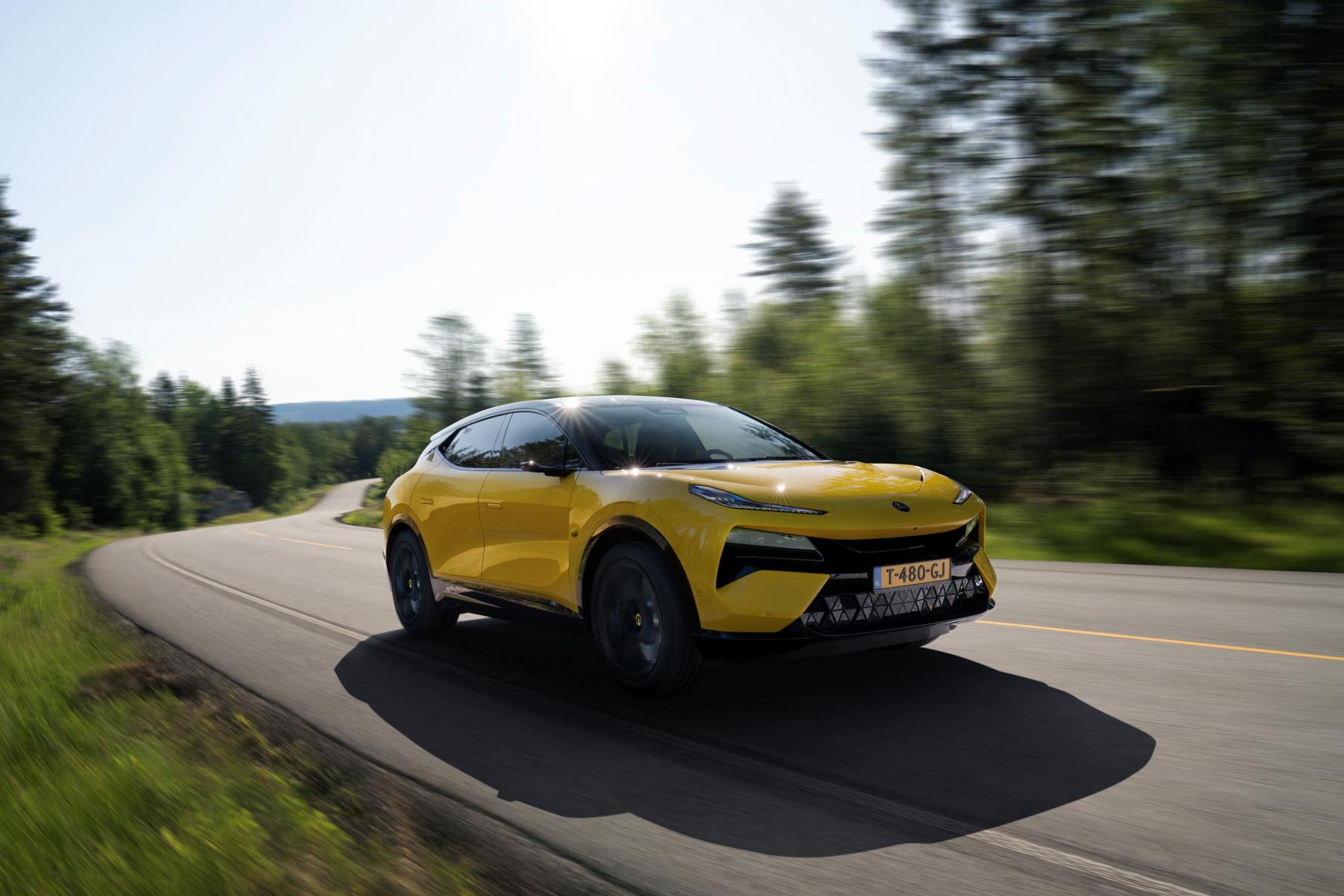
Dual-motor all-electric powertrain: power, performance and efficiency
Befitting its status as a hyper-SUV, Eletre’s propulsion system technology delivers the searing performance expected of a truly rewarding, engaging, driver-focused machine, together with the energy efficiency essential for long range and day-to-day usability.
Packaged beneath the vehicle floor is a state-of-the-art, 800-volt, 112kWh Lithium-ion battery pack. Compared to conventional 400-volt systems, the 800-volt architecture reduces the operating current by half for the same power output. The benefits for the customer are threefold: less weight because smaller diameter cables can be used in the wiring harnesses; enhanced power efficiency and improved thermal management as less heat is generated; and much faster charging.
The configuration of the battery pack is innovative too. Instead of being packaged first within a number of separate modules, the prismatic cells are arranged directly within the battery’s structural casing. This has the advantages of reducing weight, and improving packaging as more cells can be housed within a given volume. The result is enhanced energy density – more than 175Wh/kg – which translates into longer range for the driver.
The battery pack’s sophisticated thermal management system and battery control module deliver the ideal operating conditions crucial to both range and durability. Precise control of heating and cooling ensures uniform heat distribution across all of the cells and ensures optimal temperatures under extremes such as high-power charging at up to 350kW, driving in sub-zero conditions or sustained high-speed cruising.
Integrating light and compact electric motors into the front and rear axles provides incredible performance and also makes Eletre the first all-wheel drive Lotus road car – a significant milestone in the brand’s evolution. The permanent magnet, synchronous motors are housed together with the transmissions and inverters inside a single, cast housing for optimum packaging efficiency. All models feature a single-speed transmission on the front axle. While the same is true for the rear axle of the Eletre and Eletre S, the Eletre R features a two-speed design: first gear has a ratio of 13.65:1, and second gear is 7.16:1. For the customer, this creates the ideal balance of superb launch performance and acceleration, together with enhanced efficiency – and therefore range – at high speeds.
Shifts are automatic, and utilise friction plate clutches for smoothness. Weighing only 156kg, the Eletre R’s rear drive unit is some 14kg lighter than comparable two-speed designs. The inverters feature state-of-the-art silicon carbide material to deliver the highest possible energy efficiency.
These highly advanced electric drive units deliver astonishing and exploitable new levels of performance to the SUV segment, together with remarkable efficiency. With 603hp and 710Nm of instant torque, the Eletre and Eletre S can accelerate from 0-100km/h (0-62mph) in only 4.5 seconds and go on to a maximum speed of 258km/h (160mph). Both can achieve a WLTP Combined range of up to 600km (373 miles)4. With an incredible 905hp and 985Nm, the Eletre R covers the benchmark sprint in just 2.95 seconds and can reach 265km/h (165mph). WLTP Combine range is 490km (304 miles).
The electric drive units also greatly enhance real-world range. Unlike a combustion engine vehicle which converts kinetic energy to heat during braking, the Eletre can recuperate a significant proportion of this because the motors act as generators during deceleration, with the energy then recharging the battery. The driver can select from two levels of regenerative braking using the two tactile paddles on the steering wheel, their intricate shapes enabled by using a metal injection moulding manufacturing process. To ensure drivers receive consistent, progressive pedal feel under all conditions, friction braking and regenerative braking are seamlessly blended together.
Another attribute that the Eletre’s effortless torque and outstanding all-wheel drive traction underpin – and one which adds another dimension to its performance – is towing capacity. Selected models are rated at 2,250kg (with braked trailer), and cars with 22-inch wheels can be specified with the optional deployable electric tow bar which shows neatly away when not in use. An additional 90kg can be carried on the roof bars, which, together with 688-litre rear (five-seat version) and 46-litre front luggage compartments, gives the Eletre the versatility and practicality to match its luxury and performance.
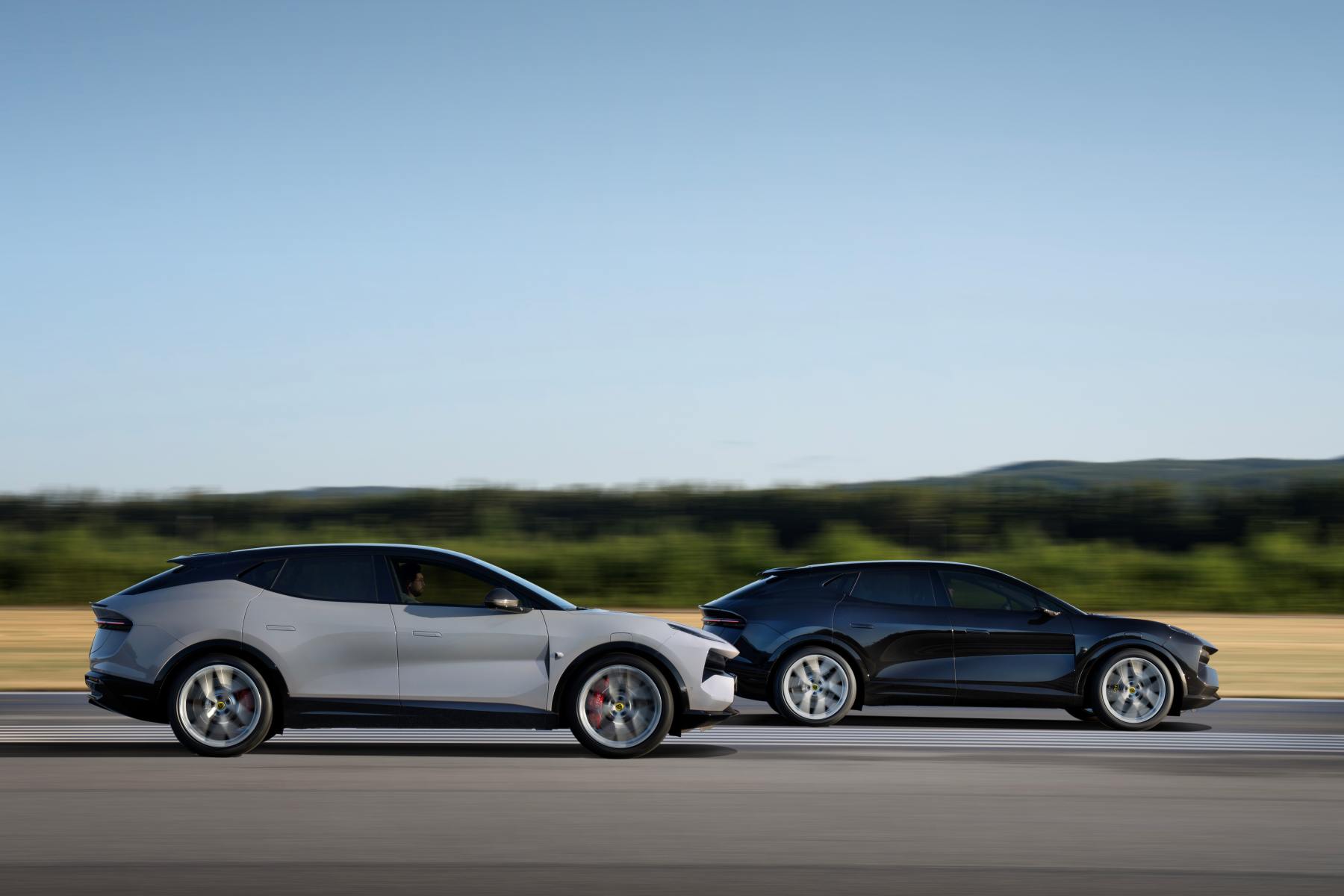
Charging: fast, simple, convenient
To enhance the ownership experience and make driving the Eletre even more enjoyable, it offers charging to match its range and performance. All models feature a 22kW on-board AC charger as standard: customers with a 22kW wallbox at home will be able to fully replenish the battery from 0-100 per cent in less than six hours – ideal for overnight charging.
Customers can also fully control how much to charge using the Lotus smartphone app. The app enables them to set the pre-conditioning function: while the vehicle is plugged-in, it uses mains electricity to heat or cool the battery to the ideal operating temperature, and brings the cabin temperature to the customer’s desired setting. This is far more efficient than drawing power directly from the battery and, as well as enhancing occupant comfort, pre-conditioning also enhances range, particularly in winter conditions when you need it the most.
When using the rapidly-growing network of public charging stations worldwide, Eletre customers benefit from the convenience of rapid 350kW DC charging. Perfect for topping-up the battery on long journeys when stopping for a break, just 20 minutes is enough to recharge from 10-80 per cent, and more than 120km (74 miles) of range can be added in only five minutes. Finding charging stations along the route is easy, thanks to the intelligent navigation system which not only highlights where they are, but also if they’re available or not.

Form and function: active aerodynamics
Eletre’s dramatic, cab-forward design evolves the iconic design language of the mid-engine Lotus sports car into a hyper-SUV. The ‘carved by air’ design ethos as seen in the Evija hypercar and Emira sports car is much more than skin deep, and seamlessly integrates a raft of active aerodynamic technologies which together enhance efficiency, performance and dynamics, and contribute to a drag coefficient of just 0.26.
One of the most significant features is the active front grille. An integral part of the Emira and Evija-inspired front end design, this comprises a row of seven individual apertures, each one featuring six triangular petals. These petals smoothly open and close on demand to meet the Eletre’s requirements for cooling airflow to the powertrain’s e-motors and radiators, and to the brakes. Crucially, in colder markets, they can stay closed to retain heat. Unique to the Eletre R, if the driver selects Track Mode, the grille is always fully open, helping to ensure the vehicle can deliver sustained, high-performance driving and braking.
The Electric Reverse Mirror Displays (ERMD)1, which use high-definition cameras to stream the view behind the vehicle to six-inch displays in the front doors, have a much smaller frontal area than traditional rear-view mirrors. As well as enhanced vision, the ERMD technology can reduce the wind resistance coefficient by up to 1.5 per cent, further improving aero performance and useable range.
Delivering the same benefit is the deployable, state-of-the-art LIDAR sensor mounted at the top of the windscreen and front wheel arches. These remain hidden when not in use by the Eletre’s comprehensive suite of advanced driver assistance systems.
Another innovation is the Eletre’s active rear spoiler, packaged neatly into the tailgate. Working in combination with the distinctive split floating roof spoiler above, it automatically adjusts between three positions, depending on vehicle speed, acceleration, braking and Drive Mode setting.
When deployed at an angle of 18º, the spoiler can reduce the drag coefficient by up to 1.8%, while also increasing downforce by up to 60kg; moving to 32º increases the drag coefficient slightly, by 1.8%, but more than doubles downforce to 112.5kg. Fully deployed to 34º delivers maximum deceleration to assist maximum braking effort.
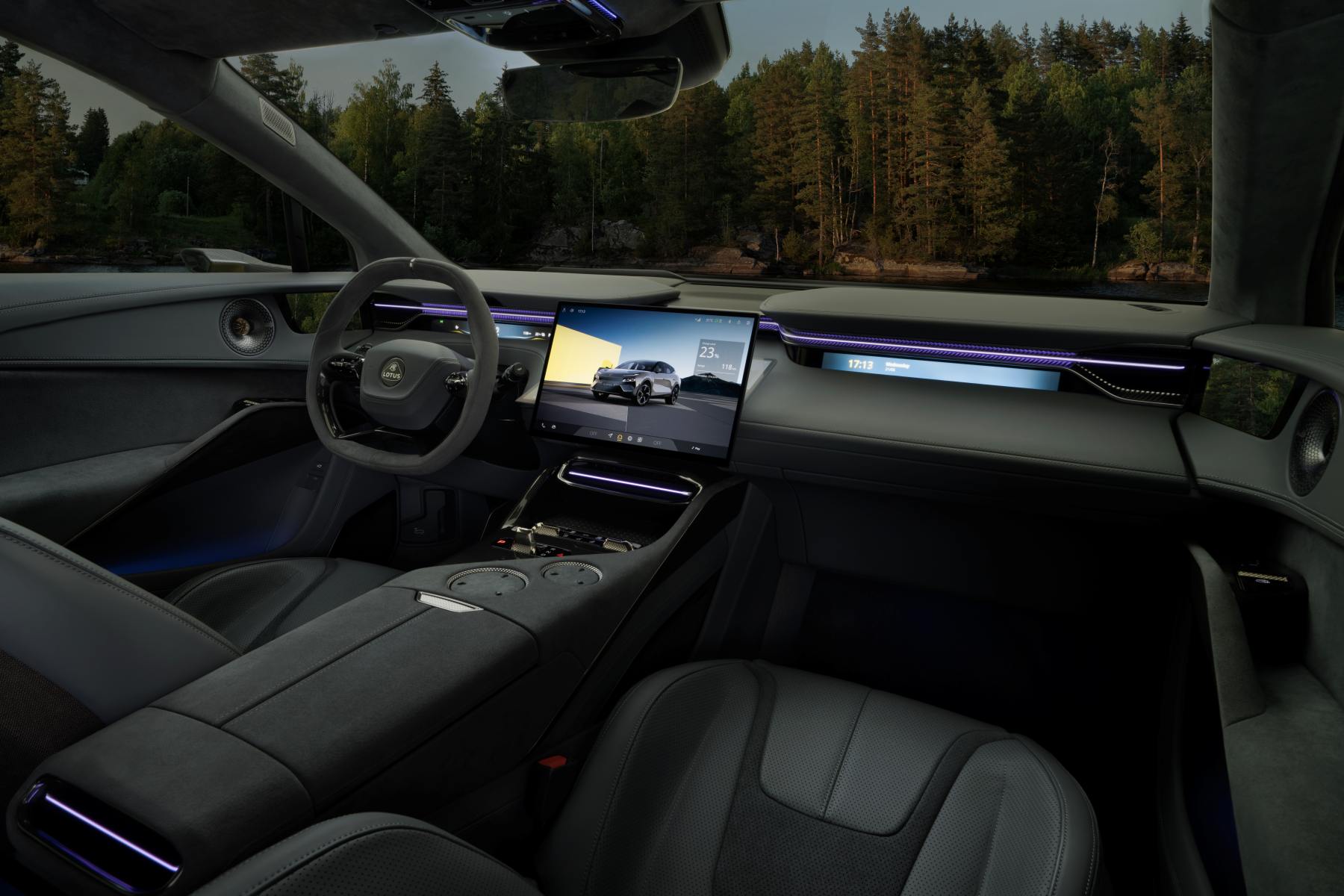
Lotus Eletre inside: the digital cockpit
The Eletre has an interior like no Lotus before it. The luxurious, spacious cabin effortlessly fuses a performance-orientated, technical design with world-class infotainment and connectivity and a curated selection of the very finest materials and finishes which convey luxury, exclusivity and precision craftsmanship – with an equal focus on sustainability.
The Eletre’s intelligent ‘Digital Cockpit’ uses cutting-edge technology to enhance the driving experience by combining beautifully rendered graphics, super-fast responses and intuitive operation. Lotus Hyper OS – an all-new operating system making its debut in Eletre – provides a seamless interactive experience that offers best-in-class performance and interactive feedback, putting the user – driver or passenger – in complete control.
The specification includes dual Qualcomm 8155 Snapdragon chips for exceptional processing power, together with 12GB of RAM and 128GB of storage. Use of ‘Unreal Engine’ technology from the world of computer gaming enables real-time 3D animations and experiences. The best possible connectivity is ensured by 5G compatibility. Software-over-the-air capability ensures the Eletre’s Digital Cockpit is always up to date, and continuously improves over time as new functionality becomes available.
Another innovation is a virtual personal assistant so that customers can interact with the vehicle just by speaking: simply say “Hi Lotus, I’m cold”, for example, and the cabin temperature is adjusted accordingly, enabling drivers to keep their hands on the steering wheel and eyes on the road.

The central touchscreen is a slimline, deployable, 15.1-inch HD OLED design that’s only 10mm thick. Able to display beautifully crisp, clear images using over 16 million colours, it offers exceptional clarity and a truly immersive experience for the driver. Navigation functionality, developed with HERE Technologies (for UK and European markets), includes EV Routing, EV Range Assistant and Predictive Routing. Beneath the touchscreen in the centre console is a wireless device charger to complement wireless Apple CarPlay and Android Auto2.
The front seat passenger has a high-definition touchscreen of their own, enabling them to control media playback and see information corresponding to voice control commands or receive prompts such as fasten seatbelt. In the rear, passengers can control climate control settings, seat adjustments, ambient lighting and media playback through a further HD touchscreen – an eight-inch or nine-inch deployable display for five-seat or four-seat configurations respectively.
The 12.6-inch HD OLED instrument cluster behind the steering wheel is paired with a 29-inch head-up display (HUD) with semi-augmented reality to help the driver keep their eyes on the road. By projecting graphics which help to convey key information such as navigation or advanced driver assistance system alerts over corresponding objects up ahead, the HUD can make it quicker and easier for the driver to understand what’s happening around them, reducing distraction and enhancing safety.
Ensuring that every occupant can enjoy an unrivalled music experience, the Eletre offers two audio systems developed with KEF. KEF Premium is a 1,380-watt, 15-speaker, surround sound system, while KEF Reference is a 2,160-watt 23-speaker system featuring 3D surround sound and space-saving Uni-Core™ technology, and the Eletre is the first vehicle to offer it. To enhance depth, precision and clarity, both systems are combined with Dolby Atmos, and the pairing of this technology together with KEF Audio is another first.
A smartphone app developed for the Eletre enables customers to interact with the vehicle wherever they are. As well as using the app to control charging and pre-conditioning, it allows them to change climate control settings, purify the cabin air, remotely lock or unlock the vehicle, or just check information such as available range. Drivers can even use the app to remotely park the vehicle, for example, in tight spaces: they can watch their Eletre manoeuvre itself into parallel, perpendicular or diagonal spaces which would otherwise be too small if the occupants had to open the doors to get out.
Digital technology has even been applied to the panoramic glass roof3: it offers 10 different settings for the amount of light transmitted into the cabin. And, compared to conventional designs which use a separate sunblind, it offers better heat insulation, helping to reduce the energy consumption of the climate control system.
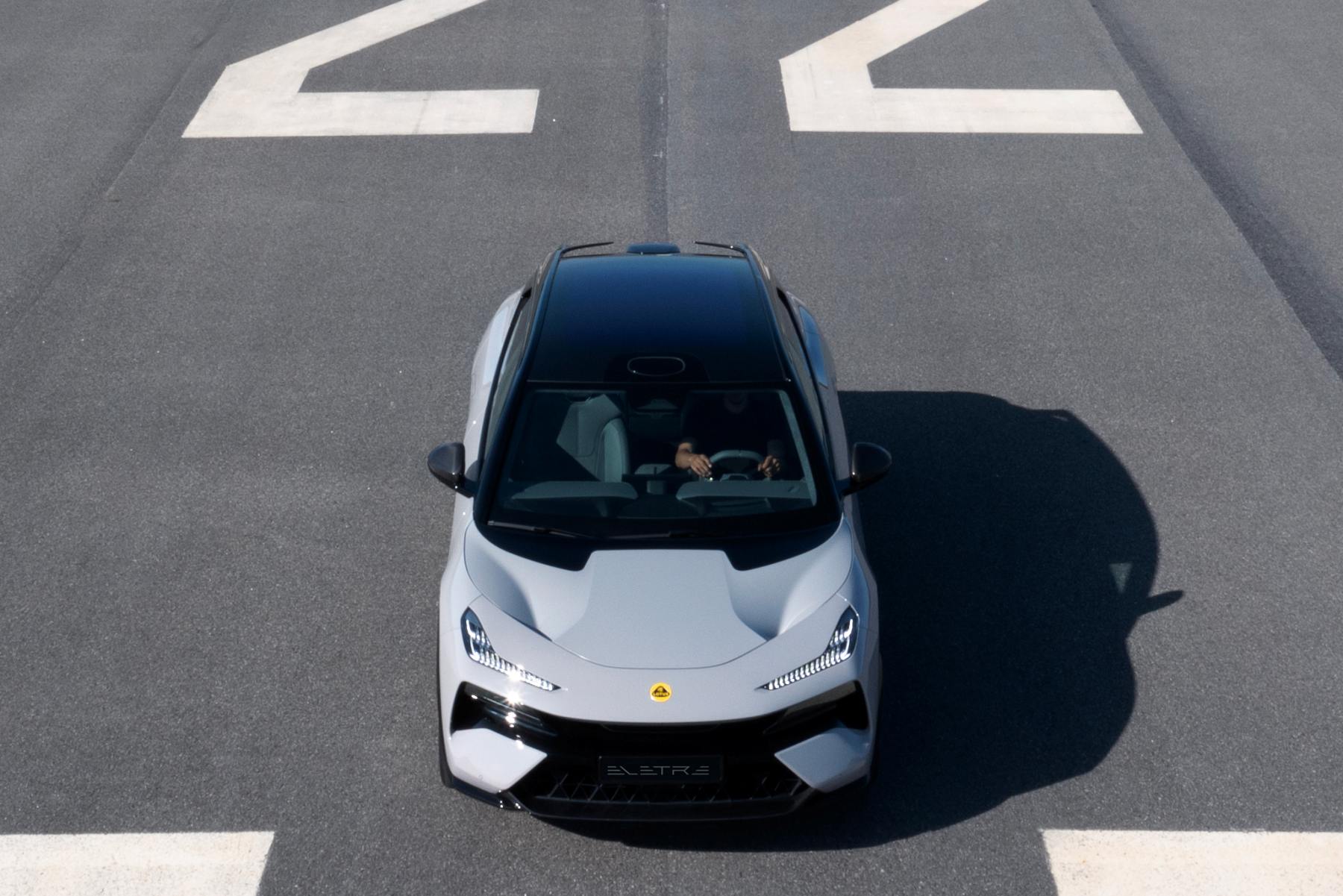
Advanced Driver Assistance Systems: safety, future-proofed
The Eletre is equipped with a full suite of advanced driver assistance systems (ADAS), all designed to enhance safety and make journeys more relaxing. To deliver this, a full complement of state-of-the-art sensors are used: 34 in total, including the four deployable LIDAR, six radar, seven 8MP HD cameras and 12 ultrasonic sensors. All together, they give the vehicle a true 360º view of the world around it.
To manage real-time processing of this wealth of data are two NVIDIA Orin-X chips, which provide a computing power capability of 500 TOPS – a phenomenal 500 trillion operations per second – and provide a fail-safe system architecture for enhanced functional safety. This level of technology, together with software and feature updates over-the-air, ensures that the Eletre not only provides the very latest ADAS functionality but is also able to deliver Level 4 autonomous driving capability as market regulations allow.
Eletre customers will be able to benefit from Highway Assist, which is designed to make long distance motorway driving more comfortable. Available from 30-150km/h, this builds on the Adaptive Cruise Control system’s management of speed and distance to vehicles in front by also automatically keeping the vehicle centred in its lane – even in bends.
Tiredness and driver distraction are among the main causes of road accidents, so Lotus has developed a Driver Monitoring System (DMS) which can help and support the driver if it determines that they’re not focused on the road ahead. Inside the cabin, near-infrared light is sent out which is reflected by the driver’s eyes and picked up by a camera: this determines, through filtering and complex calculations, where the driver is looking. Combined with other inputs such as the rate and duration of every blink, how the mouth is closed or open, and the way in which the vehicle is being driven, DMS can determine if there is a risk of them falling asleep or not paying attention to the road ahead. If these scenarios occur, visual and audible warnings are triggered, encouraging the driver to stop and take a break.
Another innovation is Life Detection and Care – a system designed to protect children or pets inadvertently left inside a locked vehicle. Should this occur, CPD will initiate three levels of warning: within 10 seconds of the vehicle being locked, the Eletre’s horn will sound and the lights will flash, and a notification will be sent to the driver. If the driver doesn’t act, the signals from the horn and lights will continue for five minutes. If no action is taken after five minutes and the temperature inside the cabin exceeds 35ºC, an emergency call will be made to the authorities to alert them to the potential risk, the windows will be lowered and a new notification will be sent to the driver.
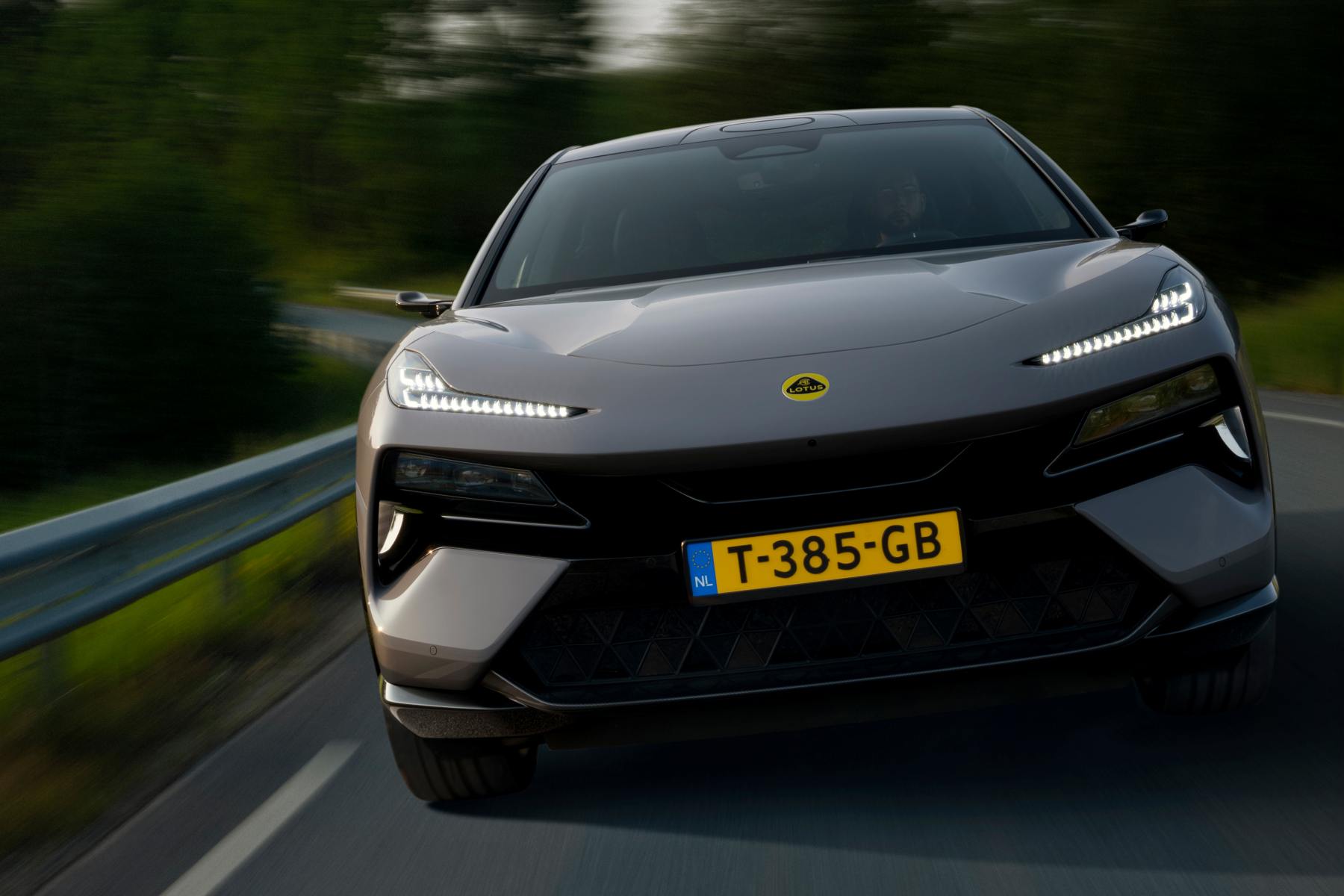
Lotus Eletre Exterior design: daring and dramatic
Embracing the creative freedom which comes from the absence of a petrol engine, the Eletre’s dramatic form interprets 75 years of Lotus sports car design DNA into a stunning new theme befitting the brand’s first all-electric hyper-SUV. It is characterised by a cab-forward stance, long wheelbase and very short overhangs front and rear. Overall, there’s a visual lightness to the vehicle, creating the impression of a high-riding sports car rather than an SUV.
A signature element of the design is its ‘porosity’ – the aerodynamic principle of air flowing through the vehicle as well as under, over and around it. Porosity was at the heart of the Lotus Evija’s design, is integral to the Emira, and has provided clear inspiration for the Eletre. It is most obvious where air is channelled under the leading edge of the vehicle, emerging through two exit vents in the bonnet.
There are other examples of porosity ahead of and behind the front wheel arches, behind the rear wheels, and even at the top of the D-pillar. For the driver, the benefits are clear: the reductions in aerodynamic drag that they deliver improve both performance and range.
At the front of the Eletre, the very sharp and crisp leading edge reveals a clear lineage with the Emira and Evija. It draws a distinct line across the very striking and contemporary design treatment below. There are further echoes of Evija in the layering of the surfaces, the creation of space and the optimised, streamlined performance.
Just above the leading edge are the super-slim, technical light clusters which house the Daytime Running Lights and scrolling directional indicators. The full LED headlights, which use Matrix technology to permit constant high beam use without dazzling the vehicle in front, or oncoming traffic, are housed below, recessed and partially hidden. The headlights also feature an industry-first High Beam Spot Module with an incorporated active cornering light to increase visibility on dark, twisty roads. The module is light, compact and simple – a true Lotus story, combining two features in one design. Lower down is the Eletre’s active front grille, a further example of the vehicle’s porosity.
Overall there is a unique sense of flow and a kinetic quality to the Eletre’s front end, the purity of which is enhanced by the deployable LIDAR sensor mounted at the top of the windscreen, which remains in its lowered position when not in use. The bold leading edge of the bonnet continues round into the front fenders, wheel arches and, ultimately, the length of the vehicle as a feature line. The taut and muscular lines are dominant above it, with the aerodynamic elements below.
In profile, the muscular haunches dominate. The air outlet immediately behind the front wheels defines the sculpted shape of the doors, which also feature deployable technology for the handles, allowing the surfacing to flow smoothly along the bodyside.
The aggressive rake of the windscreen – a sports car-like 27º – is clearly visible in profile, with the roofline tapering away dramatically at the rear, leading to a unique floating D-pillar that features an innovative ‘air blade’ which aids drag reduction. Another example of porosity, it’s an aerodynamic performance enhancement taken directly from the front bumper of the Emira.
At the rear, the full-width ribbon light strip picks up the feature line from the profile. Situated just above the Lotus wordmark, it is red when the vehicle is moving and includes a scrolling directional indicator at each end, where it curves gently into the air outlets from the wheel arches – another design cue which echoes both the Emira and Evija. The light can appear in four colours, playing a role in the car’s theatrical unlocking sequence and also indicating the battery’s charge status. The unique cantilevered carbon fibre ‘floating’ split roof spoiler is a motorsport-inspired design feature that evokes race car winglets. The central section is removed to reduce weight – a very Lotus concept – and allows the LIDAR sensor to be integrated at the top of the glass.
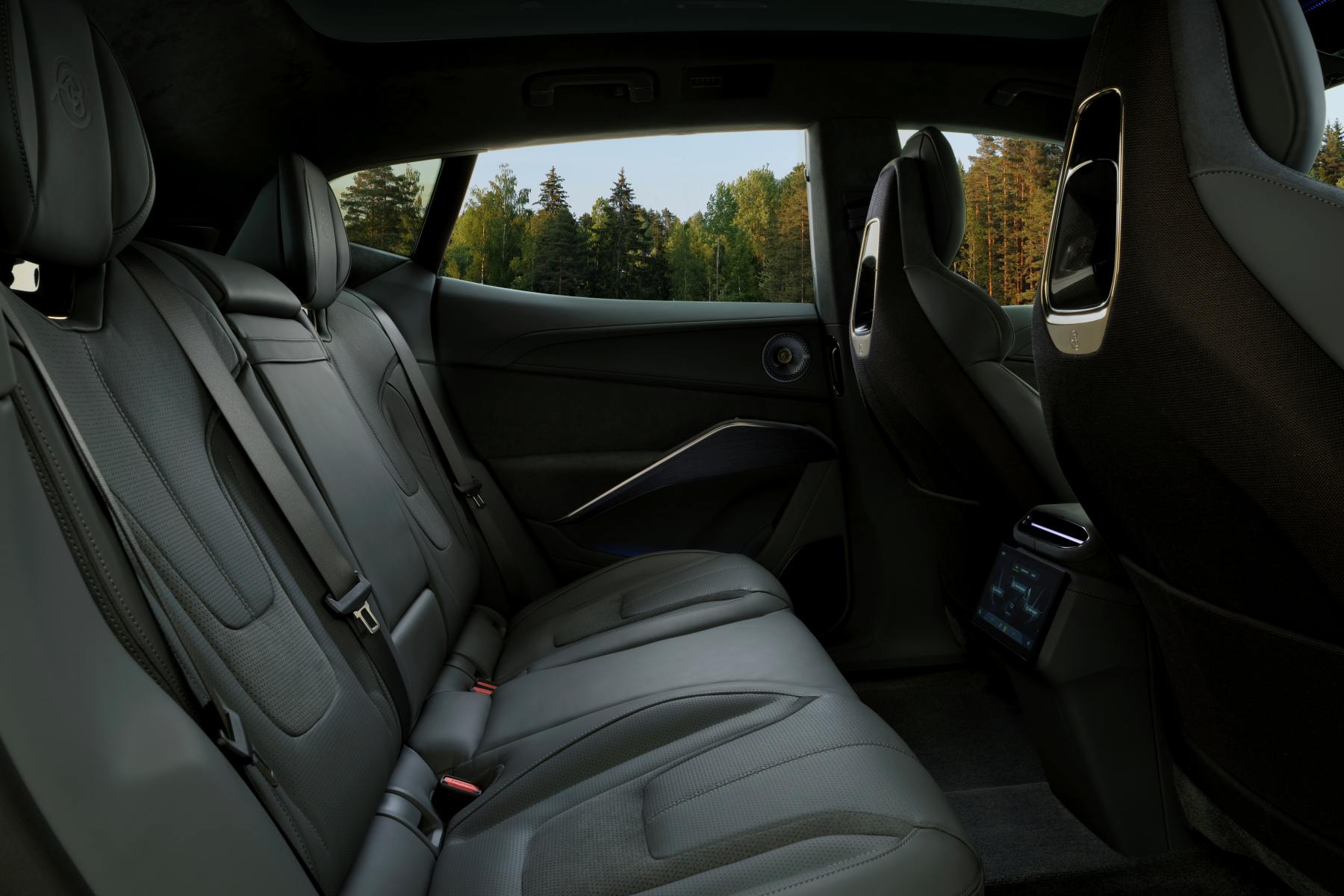
Lotus Eletre Interior design: luxurious, spacious
The Eletre takes Lotus interiors to an unprecedented new level. The performance-oriented and technical design is visually lightweight, using ultra-premium materials to deliver an exceptional customer experience, whether in the standard five-seat configuration or the optional four-seat layout. Above, a fixed panoramic roof2 floods the interior with natural light, adding to the bright and spacious feeling inside.
The driver-focused cockpit and high centre console are inspired by the Lotus Emira and Evija, creating a cossetted feeling. The layering of materials and textures creates a truly premium feel, augmented by a triangular theme – seen externally on the car’s active front grille – and replicated in multiple locations around the cabin.
The Lotus philosophy of lightweighting – removing material wherever it’s not needed – is clearly illustrated in the instrument panel. The floating wing’s central section has been taken out, echoing the design of the rear spoiler.
There is a wealth of practical storage space in the Eletre’s cabin. The centre console includes a storage tray with wireless phone charging functionality, as well as twin cupholders which remain flush to the surface until they’re needed. The beautifully sculpted door design includes storage which can accommodate a one litre bottle. Occupants in the rear of the four-seat configuration also have a wireless charging mat, and when the middle rear seat of the five-seat configuration isn’t being used, it can be folded to become an armrest, also with two deployable cupholders.
Sustainability is also a key theme of the interior. A Lotus innovation which makes its debut in the Eletre is the Re-Fibre. A premium textile made from waste fabric from the fashion industry, this material has the softness of cotton, the lustre of silk and the smoothness of hemp, offering a new vision of sustainable luxury. Enhancing comfort, it also offers better air permeability than pure cotton. Offering a weight saving compared to leather, it also reduces consumption of raw materials and reduces CO2.
Customers can also choose Ultrafabric polyurethane seats. This material offers a technical finish and is half the weight of leather, which is perfectly aligned to the Lotus ethos of lightweighting. There’s also Alcantara: this microfibre material has been carbon neutral since 2009, and the material offered in the Eletre has been offset to zero carbon footprint. Carpets are made from Econyl – a material made from 100% post-consumer waste which is also fully recyclable.
Lotus Eletre: a milestone car for a milestone moment
With the Emira confirmed as the final combustion engine Lotus sports car, the Eletre’s significance as the first all-electric Lotus hyper-SUV is made all the more significant: it is a key milestone in the brand’s dramatic transformation as it embraces a bold new electrified era. Lotus has always used technical innovation, advanced aerodynamics and lightweighting to create vehicles which set the class benchmark for performance, rideand handling. The Eletre proudly continues this tradition, but with a step-change in versatility and usability, ensuring that the Lotus brand appeals to driving enthusiasts around the world like never before.
1 – Eletre is fitted with standard mirrors in markets where local regulations do not allow ERMD
2 – Not available in China
3 – Panoramic glass roof is optional in markets outside China
4 – With 20-inch wheel
Lotus Eletre: Technical Specification
Powertrain and performance:
| Eletre | Eletre S | Eletre R | |
| Powertrain configuration | Full-time all-wheel drive with
Lotus ICC intelligent torque distribution |
||
| Electric motor front / rear | Permanent magnet / Permanent magnet | ||
| Transmission front / rear | Single speed | Single speed | Single speed/ Two-speed |
| Max power (kW / hp) | 450 / 603 | 450 / 603 | 675 / 905 |
| Max torque (Nm) | 710 | 710 | 985 |
| Top speed (mph / km/h) | 160 / 258 | 160 / 258 | 165 / 265 |
| 0-62 mph / 0-100 km/h (secs) | 4.5 | 4.5 | 2.95 |
| 80-120 km/h (secs) | < 2.0 | < 2.0 | < 1.9 |
| Battery capacity (kWh) | 112 | 112 | 112 |
| Battery type | Lithium-ion | Lithium-ion | Lithium-ion |
| Battery voltage | 800 | 800 | 800 |
| Charging time 10-80% (mins) via 350kW DC rapid charger | 20 | 20 | 20 |
| Charging time 0-100% (hours) via 22kW AC wallbox | 5.8 | 5.8 | 5.8 |
| WLTP Combined range (km / miles) | 600 / 373* | 600 / 373* | 490 / 304 |
* Using 20-inch wheel, available as a no-cost option in the UK
Chassis
| Front suspension | Multi-link | ||
| Rear suspension | Multi-link | ||
| Springs | Dual-chamber air | ||
| Dampers | Continuous Damping Control | ||
| Steering | Electromechanical; rack and pinion | ||
| Front brake diameter (mm) | 412 | 412 | 412 |
| Front brake caliper | 6-piston
(4-piston in EU) |
6-piston | 6-piston |
| Rear brake diameter (mm) | 397 | 397 | 397 |
| Rear brake caliper | Sliding caliper with Electric Park Brake | Sliding caliper with Electric Park Brake | Sliding caliper with Electric Park Brake |
Dimensions (mm):
| Length | 5,103 | ||
| Width with Electric Reverse Mirror Displays | 2,135 | ||
| Width with door mirrors | 2,231 | ||
| Track front / rear | 1,706 / 1,684 | ||
| Height | 1,630 (20-inch wheel)
1,636 (22/23-inch wheel) |
||
| Wheelbase | 3,019 | ||
| Drag Coefficient (from) | 0.26 | ||
| Kerb weight (kg) | From 2,490 | From 2,520 | From 2,640 |
| Ground clearance | 187 (20-inch wheel)
194 (22/23-inch wheel) |
||
| Rear luggage compartment capacity | 611 litres (four seats)
688 litres (five seats) |
||
| Rear luggage compartment capacity (five-seater, rear seats folded) |
1,532 litres | ||
| Front luggage compartment capacity | 46 litres | ||
Lotus Eletre: Pricing (from)
| Eletre | Eletre S | Eletre R | |
| UK (GBP) | 89,500 | 104,500 | 120,000 |
| Germany (EUR) | 95,990 | 120,990 | 150,990 |
| Netherlands (EUR) | 98,690 | 124,090 | 154,090 |
| Belgium (EUR) | 98,690 | 124,090 | 154,090 |
| France (EUR) | 97,890 | 123,090 | 153,090 |
| Italy (EUR) | 98,490 | 124,090 | 154,890 |
| Norway (EUR) | 999,990 | 1,299,990 | 1,650,990 |
| Sweden (SEK) | 1,130,990 | 1,420,990 | 1,750,990 |
| Switzerland (CHF) | 116,090 | 144,890 | 180,890 |

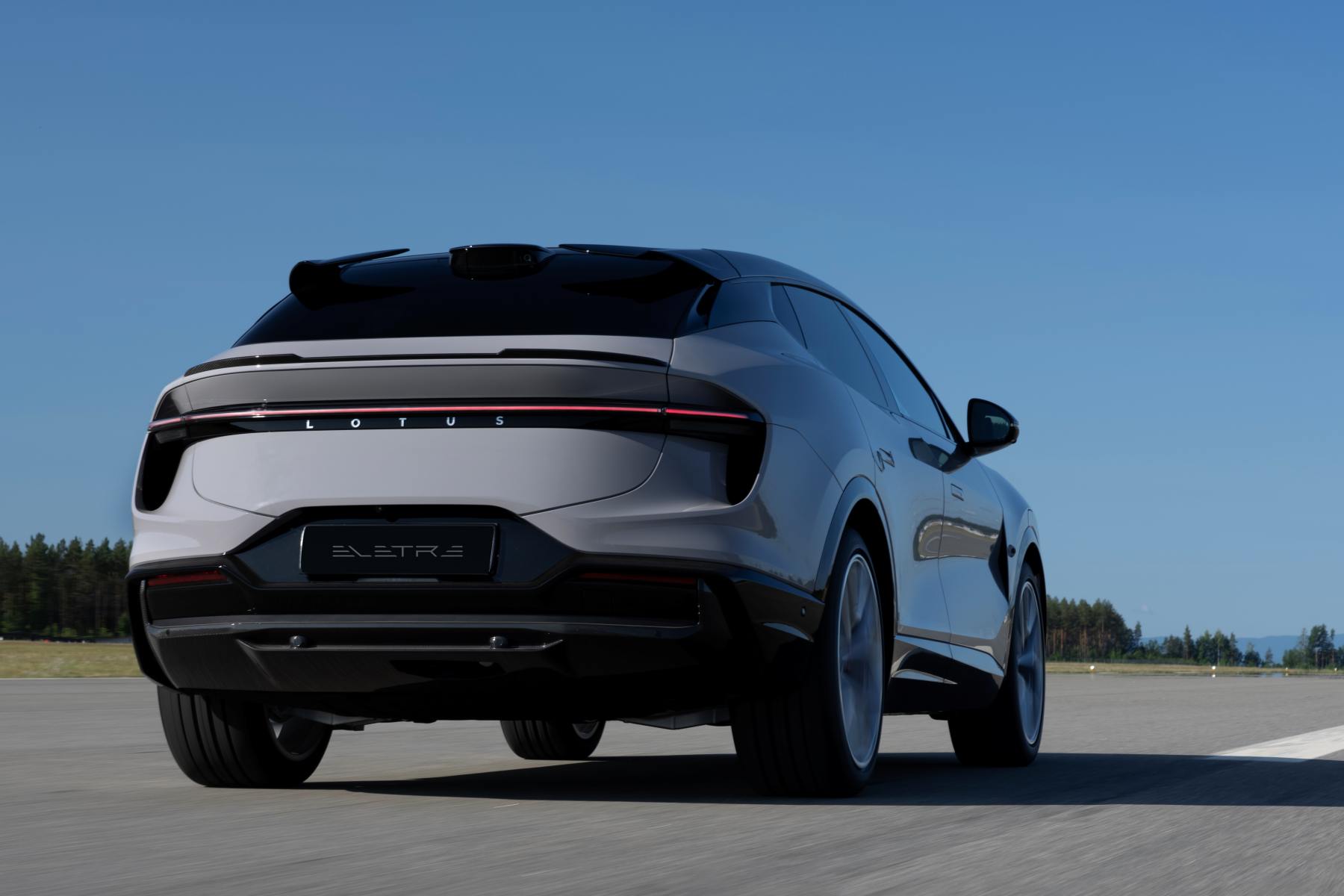
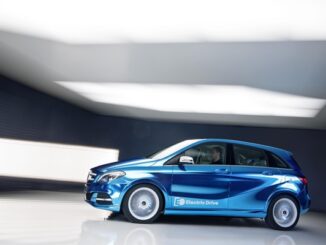
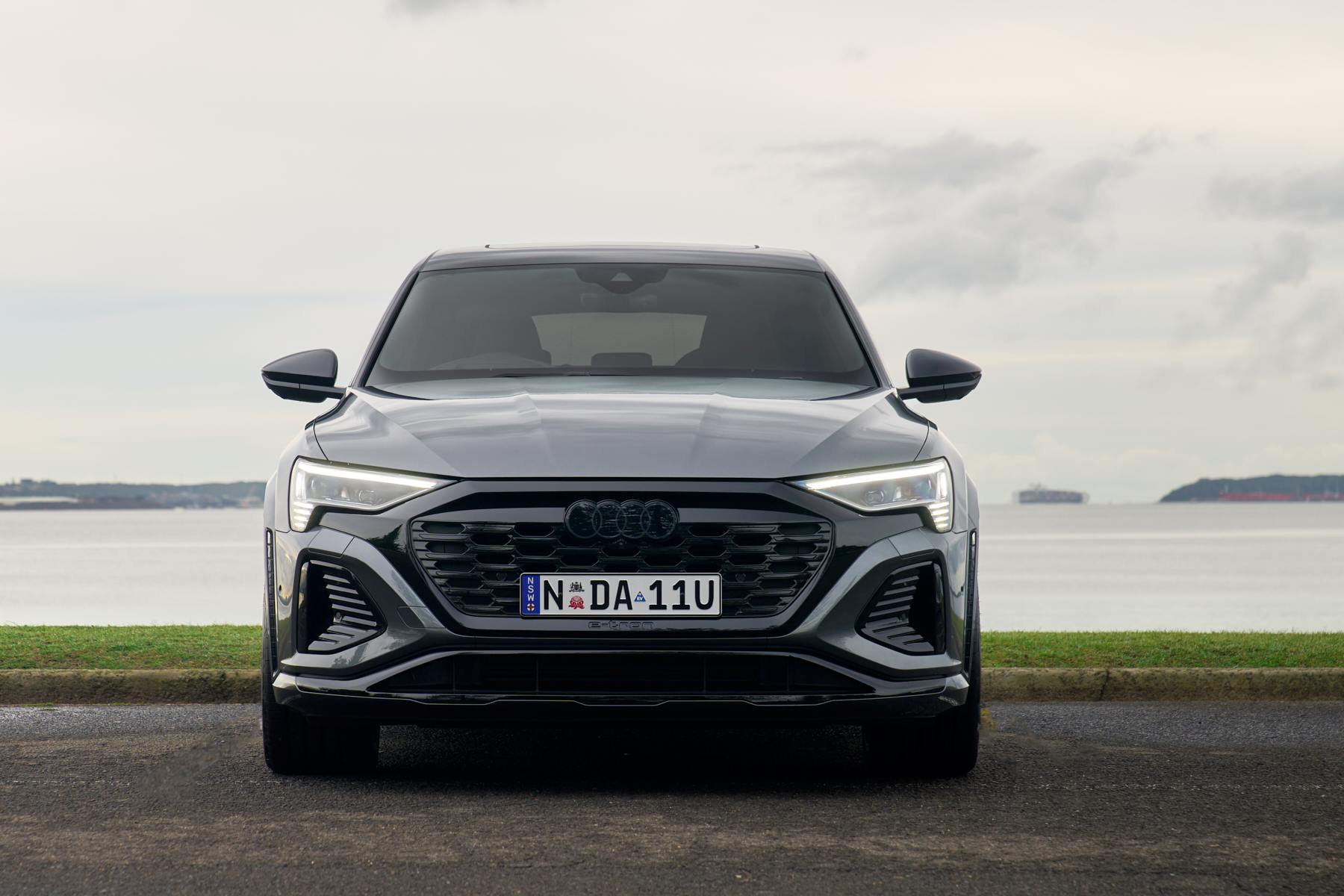
Be the first to comment